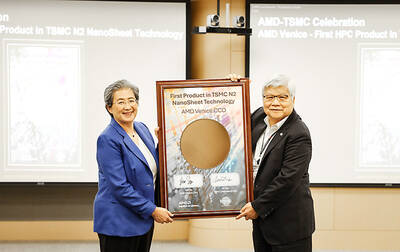Export orders last month grew for the eighth straight month at an annual rate of 4.9 percent, benefiting from rising demand for advanced chips used in artificial intelligence (AI) and high-performance computing (HPC) applications, the Ministry of Economic Affairs said yesterday.
Export orders expanded to US$55.45 billion last month, compared with US$52.87 billion a year earlier and marking the strongest level since September 2022, ministry data showed.
In the first 10 months, accumulated export orders totaled US$484.35 billion, up 3.8 percent annually, the data showed.

Photo: CNA
Orders for electronic products, including semiconductors, registered the fastest annual growth of 11.2 percent last month to US$20.91 billion, marking the best October performance. Orders for the US market surged 12.6 percent annually to US$19.15 billion, making it the fastest growing market in the month, the ministry said.
“Last month’s performance matched our expectations, mostly driven by the electronics segment, or mostly advanced chips. For the full year, we expect export orders to return to the annual growth path,” Department of Statistics Director Huang Yu-ling (黃于玲) said.
“What is more, the traditional industries are recovering, too, as reflected in last month’s figures. Their growth may look mild, but the uptrend is confirmed,” she added.
Export orders this month are expected to grow between 4.7 percent and 8.6 percent year-on-year to between US$53 billion and US$55 billion, the ministry said.
That would represent a sequential reduction of between 0.8 percent and 4.4 percent, in line with seasonal patterns, the ministry said.
“Advanced chips and AI servers are the growth drivers,” Huang said.
Information and communications technology products last month saw orders rise 0.5 percent annually to US$17.58 billion as strong demand for AI and cloud-based applications fueled demand for servers and networking equipment, the ministry said.
Orders for optronic products shrank 0.7 percent to US$1.66 billion last month, due to falling prices of TV display panels, but those for base metals advanced 7.4 percent to US$2.13 billion, thanks to rising demand for steel products, it said.
Orders for machinery products and mechanical equipment rose 5 percent to US$1.54 billion last month, primarily driven by robust demand for semiconductor manufacturing equipment and automation systems, the ministry said, adding that orders for machine tools dipped.
Orders for plastic and rubber products edged higher by 1.8 percent to US$1.54 billion last month attributable to the growth of rubber material and gloves, while plastic raw material demand sank due to competition from global rivals, the ministry said.
Chemical orders climbed 3.9 percent to US$1.39 billion last month, benefiting from rising demand for medicine and electronic chemicals, but petrochemical orders dropped on lower prices, it said.

TAKING STOCK: A Taiwanese cookware firm in Vietnam urged customers to assess inventory or place orders early so shipments can reach the US while tariffs are paused Taiwanese businesses in Vietnam are exploring alternatives after the White House imposed a 46 percent import duty on Vietnamese goods, following US President Donald Trump’s announcement of “reciprocal” tariffs on the US’ trading partners. Lo Shih-liang (羅世良), chairman of Brico Industry Co (裕茂工業), a Taiwanese company that manufactures cast iron cookware and stove components in Vietnam, said that more than 40 percent of his business was tied to the US market, describing the constant US policy shifts as an emotional roller coaster. “I work during the day and stay up all night watching the news. I’ve been following US news until 3am

UNCERTAINTY: Innolux activated a stringent supply chain management mechanism, as it did during the COVID-19 pandemic, to ensure optimal inventory levels for customers Flat-panel display makers AUO Corp (友達) and Innolux Corp (群創) yesterday said that about 12 to 20 percent of their display business is at risk of potential US tariffs and that they would relocate production or shipment destinations to mitigate the levies’ effects. US tariffs would have a direct impact of US$200 million on AUO’s revenue, company chairman Paul Peng (彭雙浪) told reporters on the sidelines of the Touch Taiwan trade show in Taipei yesterday. That would make up about 12 percent of the company’s overall revenue. To cope with the tariff uncertainty, AUO plans to allocate its production to manufacturing facilities in

COLLABORATION: Given Taiwan’s key position in global supply chains, the US firm is discussing strategies with local partners and clients to deal with global uncertainties Advanced Micro Devices Inc (AMD) yesterday said it is meeting with local ecosystem partners, including Taiwan Semiconductor Manufacturing Co (TSMC, 台積電), to discuss strategies, including long-term manufacturing, to navigate uncertainties such as US tariffs, as Taiwan occupies an important position in global supply chains. AMD chief executive officer Lisa Su (蘇姿丰) told reporters that Taiwan is an important part of the chip designer’s ecosystem and she is discussing with partners and customers in Taiwan to forge strong collaborations on different areas during this critical period. AMD has just become the first artificial-intelligence (AI) server chip customer of TSMC to utilize its advanced

Six years ago, LVMH’s billionaire CEO Bernard Arnault and US President Donald Trump cut the blue ribbon on a factory in rural Texas that would make designer handbags for Louis Vuitton, one of the world’s best-known luxury brands. However, since the high-profile opening, the factory has faced a host of problems limiting production, 11 former Louis Vuitton employees said. The site has consistently ranked among the worst-performing for Louis Vuitton globally, “significantly” underperforming other facilities, said three former Louis Vuitton workers and a senior industry source, who cited internal rankings shared with staff. The plant’s problems — which have not